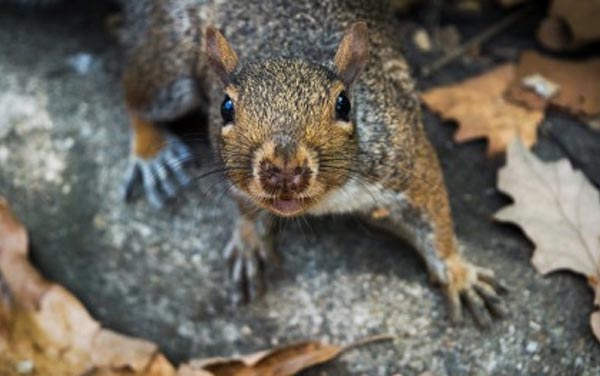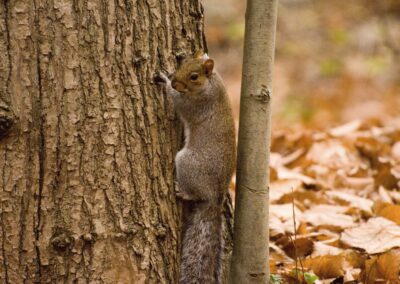Understanding grey squirrel damage in UK woodlands
Project leads Dr Robin Gill | Forest Research; Alexandra Ash | PhD Student, University of Southampton
Lead organisation Forest Research
Collaborators Prof Patrick Doncaster | University of Southampton; Dr Rebecca Spake | University of Reading; Dr Chris Nichols | Woodland Trust; Prof John Pickett | Cardiff University; Charles Dutton | Charles Dutton & Co
Project status Active 2021-2025
Project funding £120,000
Research outcome(s) Adaptation
Context
Since their introduction to the UK in late 1800s and early 1900s, grey squirrels (Sciurus carolinensis) have caused extensive damage to broadleaf trees through bark-stripping behaviour. Recently identified by the Royal Forestry Society as a major threat to broadleaf woodland health and creation, squirrel damage undermines the UK Government’s ambitious targets to increase woodland area and mitigate the effects of climate change.
Previous research has shown how trees are susceptible to squirrel damage, but knowledge of what drives bark-stripping behaviour in grey squirrels is still lacking and current management is ineffective in targeting the behaviour. Gaining insight into the drivers and motivations of the behaviour will aid in the development of effective, humane and targeted management.
Research aims and objectives
Aim:
To establish the drivers and motivations for squirrel bark stripping behaviour.
Objectives:
This PhD project will investigate various potential causal pathways of bark-stripping behaviour in grey squirrels, and at each stage of the project aim to narrow down these pathways. It will:
- Identify and organise knowledge gaps within the squirrel bark-stripping literature.
- Identify factors of woodland susceptibility to, and drivers of bark-stripping at the regional, landscape and local scales using existing datasets.
- Identify causal mechanisms underpinning bark-stripping behaviour in broadleaved woodlands in southern England.
Expected outcomes
- A thesis plan, preliminary literature review and three annual reports .
- Peer-reviewed papers and technical recommendations for practical application of research.
- A PhD thesis.
Further resources linked to this project
CFP Phase 2 Project (Active)
This research is being built upon in CFP Phase 2 project: Understanding grey squirrel bark stripping.

40% of British forests have ‘unfavourable’ levels of herbivore damage, which limits the survival of young trees and threatens biodiversity.
Glossary & Key Terms
Bark stripping
The destructive behaviour of grey squirrels (Sciurus carolinensis) where they gnaw at the bark of trees to access the sweet, sap-filled phloem tissue beneath. This tissue is vital for the translocation of sugars throughout the tree, and when squirrels strip bark in a complete ring around the stem (a process called ring-barking), it disrupts this flow and can kill the tree.
Broadleaf
A category of trees that have wide, flat leaves rather than needle-like leaves. A category of trees that have wide, flat leaves rather than needle-like leaves. These trees are usually deciduous and lose their leaves in winter.
Grey squirrels (Sciurus carolinensis)
A non-native, invasive species originally from eastern North America. They were introduced to Great Britain in the 19th century and have since spread widely, now numbering over 2.7 million individuals across the UK. For more information on the management of grey squirrels, see Management of grey squirrels – Forest Research.
Share this project on social media
Related Projects
Our Partners
Social media
Explore
Contact
© 2022 Centre for Forest Protection. All rights reserved.


